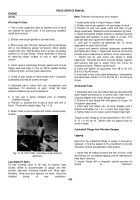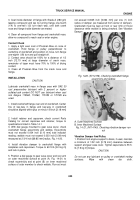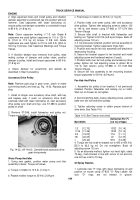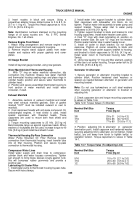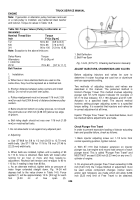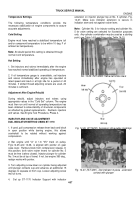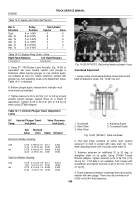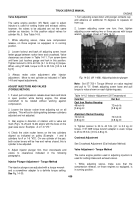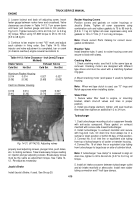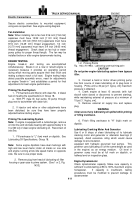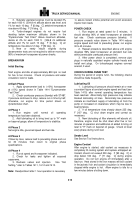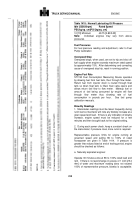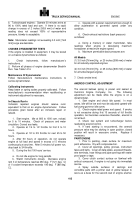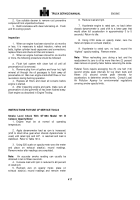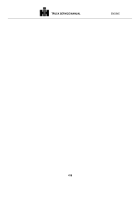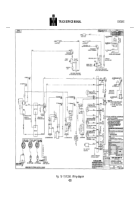TM-5-3805-254-14-P-2 - Page 416 of 894
TRUCK SERVICE MANUAL
ENGINE
INSTALLATION OF ENGINE
1. Place engine on dynamometer test stand,
secure engine mounting pads to engine support risers.
2. Position dynamometer drive shaft flange to
engine flywheel.
Check for proper alignment per
manufacturers instructions.
3. Connect water supply and return hose to the
water cooling arrangement.
4. Attach ST1190 Fuel Consumption Measuring
Device to engine.
5. If engine is equipped with an aneroid control,
disconnect fuel pressure and fuel return line and plug
lines.
The aneroid is reconnected just after "power
check" is made.
6. Connect throttle linkage instruments, exhaust
piping and air intake piping to engine.
7. On naturally aspirated engines, plug vent holes
in cylinder heads before making blowby check.
After
testing, remove pipe plugs.
8. Install
ST487
BlowBy
Checking
Tool
in
crankcase breather opening or special rocker cover.
Use water manometer and fill to "O" mark at middle of
scale.
Close all openings that would allow blowby
pressure to escape.
9. Start engine, see "Starting Procedure," open
coolant supply to engine water connection.
Introduce
water to dynamometer per manufacturer’s instructions.
Check all tubing, hose, lines, fittings and plugs for leaks.
Correct as necessary.
See "Check Turbocharger Oil
Flow" following.
10. For engine run-in, see "Test Procedure.
Check Turbocharger Oil Flow
1. Disconnect turbocharger oil drain line.
2. Start engine and maintain rpm at low idle.
3. Observe oil drain.
Oil should flow in 10 to 15
seconds.
If no oil flows in 30 seconds, shut down engine
and correct fault.
4. Reconnect oil drain line when flow is established.
STARTING PROCEDURE
Normal Without Cold-Starting Aid
1. Set throttle for idle speed, open manual fuel
shutdown valve, if used.
Electric fuel shutdown valves
operate automatically.
Note:
The manual override knob provided on forward
end of electric shutdown valve, allows valve to be
opened in case of electric power failure or if power is not
available during testing.
To use, open by turning fully
clockwise.
2. Pull compression release if so equipped, press
starter button or turn switch key to "start" position.
After
three or four seconds of cranking, close compression
release and continue to crank until engine fires.
CAUTION
Do not crank engine continuously for more than 30
seconds.
If engine does not fire, wait two to five
minutes before repeating to avoid cranking motor
damage.
Cold Start With Preheater
1. Set throttle in idle position, turn glow plug toggle
switch to "ON" position.
(Red indicator light must be on.)
After red’ light has been on for 20 seconds, start
cranking engine. As soon as engine begins rotating,
operate preheater priming pump to maintain 80 to 100
psi [5.6 to 7.0 kg/sq. cm] fuel pressure.
(Use of primer
before 20second interval will wet and cool glow plug and
prevent heating.)
Note:
On engines equipped with an oil pressure switch,
the fuel bypass switch must be In "START" position
before use of priming pump.
Hold in "START" position
until engine oil pressure reaches 7 to 10 psi [0.5 to 0.7
kg/sq. cm]then move to "RUN" position.
2. If engine does not start within 20 seconds, stop
cranking, wait two to five minutes and repeat cranking
operation.
3. After engine starts, pump primer slowly to keep
engine idling smoothly.
Do not accelerate engine.
4. When engine has warmed up so it does not
falter between primer strokes, stop pumping.
Close and
lock primer.
Turn off glow plug toggle switch.
Failure To Start
1. If engine gives no indication of starting during
first three full strokes of preheater pump, check intake
manifold for heat.
If there is no heat, check electric
wiring.
If wiring is all right, remove pipe plug from
manifold and observe glow plug.
Glow plug should be
white hot; if not, connect plug to a six or twelve volt
source and check amperage which should be 30
(minimum).
If glow plug is all right, check manual switch
and resistor; replace if necessary.
TEST PROCEDURE
Horsepower Ratings
1, The maximum horsepower ratings at rpm shown in
Table 1414, "Dynamometer Test Chart," are for engines
operating at No.1 Curve or intermittent duty applications
at sea level, 60 deg.
F [16 deg.
C] intake air
temperature and 29.92 inch [760.0 mm] Hg (Mercury)
barometric pressure.
2. Where it is necessary to derate because of high
altitude operation, the derating may be done by reducing
maximum governed rpm or maximum fuel rate.
Refer to
FUEL PUMP SYSTEM
412
Back to Top

